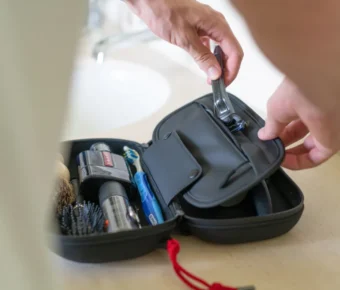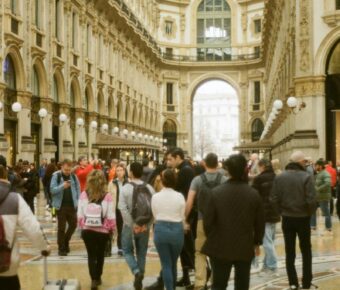
Myeongdong Itinerary: 7 Unmissable Experiences in Seoul’s Heart
Trying to plan a day in Myeongdong? Yeah, it’s a lot. There’s so much crammed into just a few blocks—markets buzzing, neon everywhere, and those little cultural spots you’d never find unless someone pointed them out. If you don’t have a loose plan, you’ll probably miss half the good stuff. A practical Myeongdong itinerary lets you hit the highlights, snack on the right street food, and still squeeze in some aimless wandering.
You’ll dodge through Seoul’s most famous shopping lanes, munch on street food that actual locals line up for, and duck into peaceful spots like Myeongdong Cathedral when the crowds get too much. If you’re clever about timing, you can even check out nearby sights before everyone else wakes up.
Honestly, it’s not just about checking off a list—it’s about catching the real vibe of Myeongdong, so you feel like you belong here, even if it’s your first time.
Table of Contents
- Key Takeaways
- Essential Tips for Planning Your Myeongdong Itinerary
- Best Time to Visit Myeongdong
- How to Get to Myeongdong Station
- Navigating Myeongdong Like a Local
- Must-See Landmarks and Cultural Highlights
- Myeongdong Cathedral
- Namsangol Hanok Village
- N Seoul Tower
- Shopping Experiences in Myeongdong
- Myeongdong Shopping Street
- Lotte Department Store
- Korean Beauty and Fashion Finds
- Street Food and Culinary Adventures
- Exploring Street Food Stalls
- Tasting Tteokbokki and Hotteok
- Breakfast at Isaac Toast
- Famous Local Restaurants and Eateries
- Dining at Myeongdong Kyoja
- Kalguksu Alley
- Nearby Food Markets
- Day Trips and Nearby Attractions
- Exploring Insadong
- Visiting Gwangjang Market
- Cultural Stops Beyond Myeongdong
- Frequently Asked Questions
- What are the top attractions to include in a Myeongdong day trip?
- How can I experience the best of Myeongdong’s street food scene?
- What is the recommended amount of time to spend in Myeongdong during a Seoul visit?
- Can you suggest a shopping itinerary for Myeongdong that includes both popular and hidden spots?
- What are some cultural experiences unique to Myeongdong that I can include in my itinerary?
- How do I balance my Myeongdong schedule with other Seoul attractions over a 5-day stay?
- Book Your Dream Experience
- More Travel Guides
Key Takeaways
- Map your route to balance shopping, food, and culture
- Hunt for authentic gems tucked off the main drag
- Use nearby attractions to stretch your Myeongdong adventure
Essential Tips for Planning Your Myeongdong Itinerary
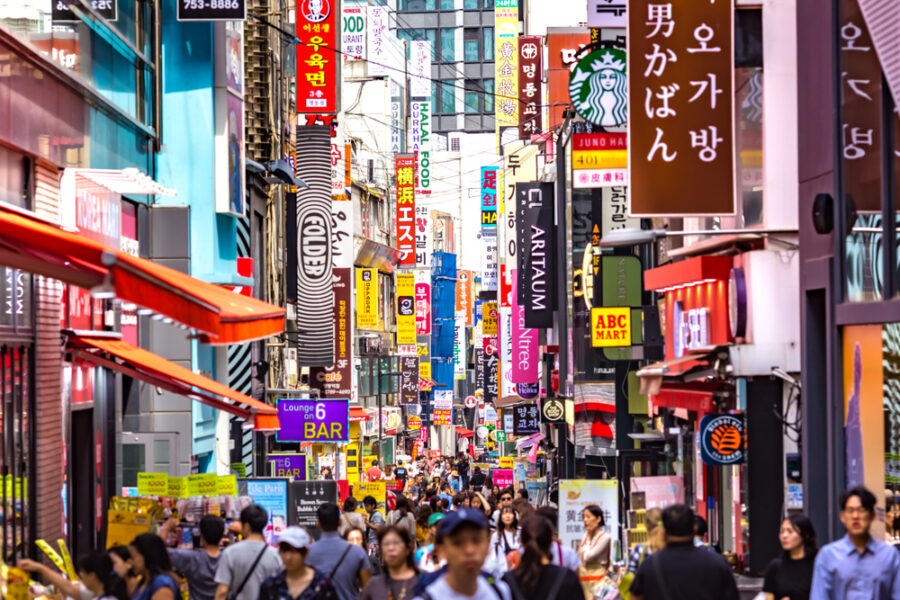
Myeongdong can really hit you with sensory overload if you show up unprepared. Shops, food stalls, and little secrets hide everywhere. If you just wander, you’ll miss a lot.
I always say, tiny details—like timing your visit, picking the right subway exit, and steering clear of those obvious tourist traps—make your day way easier.
Best Time to Visit Myeongdong
If crowds aren’t your thing, go on a weekday morning. Most shops open around 10 or 11 AM, and you can actually breathe while you walk. Evenings? They’re wild, but that’s when the street food scene really wakes up.
Spring (April–May) and autumn (September–October) feel best. Summers get sticky, and winter? Oh, the wind cuts right through you. If you’re braving winter, bundle up and don’t forget gloves—trust me, you’ll want them when you’re eating hot tteokbokki.
I’ve noticed Sundays pull in more tourists and locals. If you can, swing by on a Tuesday or Wednesday. Staying nearby? Pop in twice—quiet in the morning, and again at night for that full neon buzz.
How to Get to Myeongdong Station
Myeongdong Station sits on Seoul Subway Line 4. Coming from Seoul Station? It’s only two stops—super quick. From Incheon Airport, hop on the Airport Railroad to Seoul Station, then switch to Line 4.
Use Exit 6 if you want to hit the main shopping street right away. Exit 1 has an elevator, which is a lifesaver if you’ve got luggage or a haul of shopping bags. I’ve ended up blocks away before by picking the wrong exit, so stick with these two.
If you’re booking a hotel, double-check if it’s walkable from Myeongdong Station. Staying close means you can drop off your loot or take a breather whenever you want—finding a place nearby is honestly a game-changer.
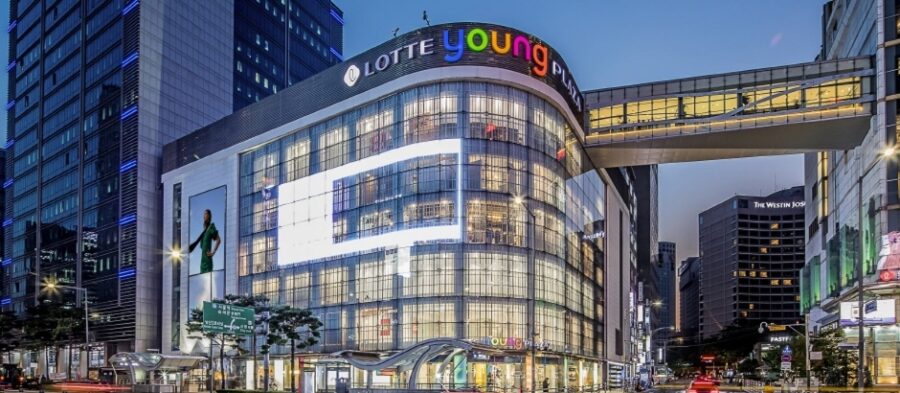
The main street runs from Exit 6 up toward Lotte Department Store, but don’t limit yourself to the obvious route. The side alleys? That’s where you’ll stumble on dumpling joints and indie skincare shops with better deals than the big chains.
Bring cash for street eats. Sure, some stalls take cards, but cash is quicker and sometimes gets you a better price. And here’s something most visitors miss—browse first, buy later. Shops often sell the same stuff, so you can compare and save.
If you’re out all day, wear comfy shoes. You’ll rack up 10,000 steps without even noticing. I always go for a small backpack or crossbody bag—way easier than a tote, especially when you’re juggling snacks and shopping. Toss in a few travel essentials like a charger or water bottle so you’re not left scrambling.
If you lose your bearings, don’t stress. Landmarks like Lotte Young Plaza or the giant Nature Republic store help you find your way fast. The streets loop around more than you’d expect.
Must-See Landmarks and Cultural Highlights
Seoul’s this wild mix of old and new, and Myeongdong nails that balance. You’ll find places to escape the chaos and get a feel for how deep the city’s roots go. Some of these spots honestly make you pause and just soak it all in.
Myeongdong Cathedral
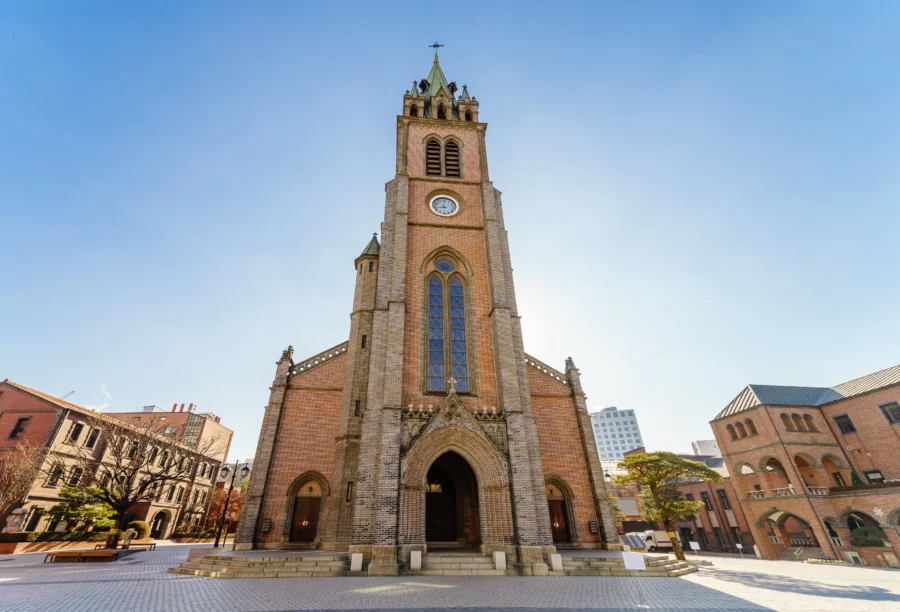
Myeongdong Cathedral stands out in the neighborhood. Built in the late 1800s, it’s Korea’s first Gothic Revival church and that spire is hard to miss from the shopping streets.
Step inside and you’ll find a calm, almost hushed atmosphere—pretty surreal compared to the noise outside. The stained glass catches the afternoon sun in a way that’s worth slowing down for.
On weekday mornings, you might catch a quiet service or see locals dropping in for a quick prayer. There’s also a small underground chapel and a little museum that reveals the cathedral’s role in Korean history, especially during some turbulent times.
Namsangol Hanok Village
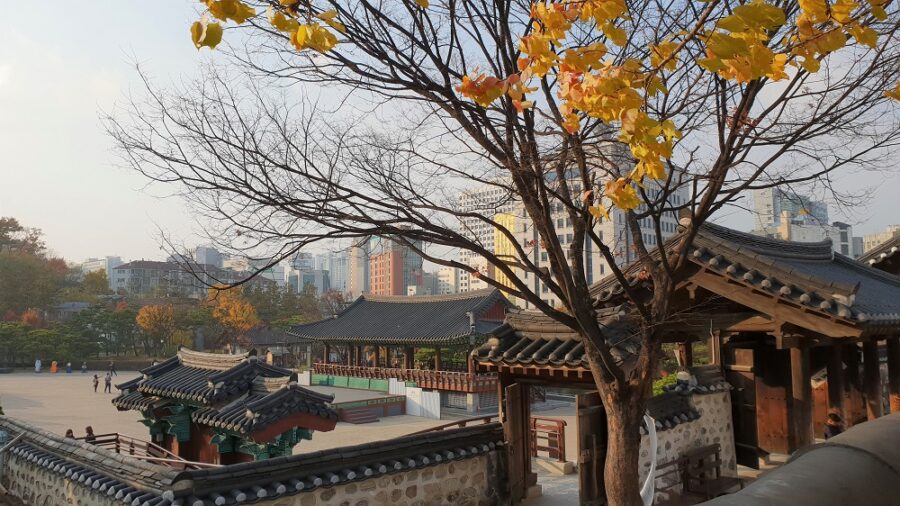
Namsangol Hanok Village sits a short walk or subway ride from Myeongdong. It’s one of my favorite spots to get a glimpse of old Seoul. The village has several restored hanok (traditional Korean houses) from the Joseon Dynasty.
You can wander through courtyards, peek into old rooms, and check out daily-life artifacts. The place feels peaceful—ponds, pavilions, and garden paths give you a break from city noise.
On weekends, you might catch a cultural show, tea ceremony, or craft workshop. If you’re into photography, this is the spot—especially in autumn when the leaves go full red and gold.
N Seoul Tower
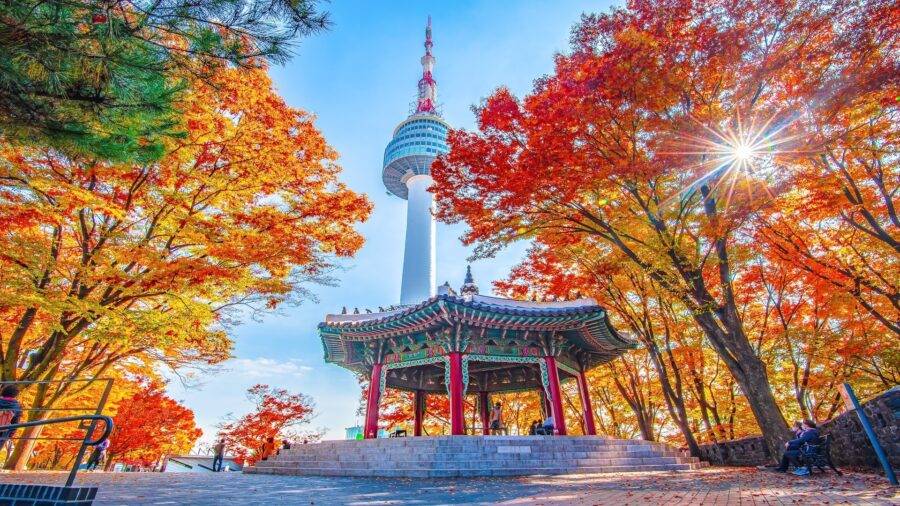
N Seoul Tower crowns Namsan Mountain and hands you some of the best city views in Seoul. Hiking up from Myeongdong takes about 30–40 minutes, but there’s a cable car if you’d rather not sweat it out.
At the top, you’ll find an observation deck, restaurants, and the “Locks of Love” fence where couples leave padlocks. The skyline at night? Unreal—lights for days.
If you catch sunset up here, you’ll see Seoul flip from day to night in real time. Just know you won’t be alone—this spot draws a crowd for a reason.
Shopping Experiences in Myeongdong

Shopping here is a wild mashup—street stalls, fancy department stores, and quirky specialty shops all jammed together. Whether you’re chasing skincare deals, the latest K-fashion, or just want to window-shop, you’ll cover a lot in a few blocks.
Myeongdong Shopping Street
This is the core of Myeongdong’s shopping scene. The pedestrian street bursts with cosmetic stores, trendy boutiques, and food vendors squeezed into every gap. Hours can pass before you know it.
Vendors usually set up by late morning and stick around until late. You’ll spot everything from hotteok stands to endless racks of K-pop socks.
If you’re visiting during peak times, go early to avoid the shoulder-to-shoulder shuffle. Cash comes in handy since not every stall accepts cards. Want something different? Duck into the side alleys for indie shops and a quieter vibe.
Tip: Tourists should look for “Tax Free” signs. Bring your passport for the refund—it’s a bit of a process but worth it.
Lotte Department Store
Just a short walk from the main street, the Lotte Department Store delivers a totally different experience. It’s sleek, cool, and organized by floors—fashion, beauty, home goods, and a killer food hall in the basement.
That basement food hall? Honestly, don’t skip it. Pastries, sushi, and boxed Korean snacks make perfect gifts (or, you know, snacks for later). The rooftop view is underrated—catch the sunset if you can.
If you’re not sure what to buy, the duty-free section curates the best Korean brands. It’s also a solid way to shop indoors if the weather’s rough or the crowds get too much.
Korean Beauty and Fashion Finds
Myeongdong’s called the capital of K-beauty for a reason. You’ll see flagship stores for Innisfree, Etude House, Nature Republic—most hand out free samples and offer skin consults.
Fashion-wise, it’s a mix. Global chains like H&M stand next to Korean labels like Stylenanda and Aland. Most styles are trendy and youthful, but you can score minimalist basics if that’s more your speed.
For skincare, always compare prices—some shops run tourist deals or bundle promos. If you’re after clothes, watch for seasonal sales, especially when they’re clearing out old stock.
Would you like me to write up the “Food Experiences in Myeongdong” section in this same style? It’ll help your itinerary flow and cover all the good stuff.
Street Food and Culinary Adventures
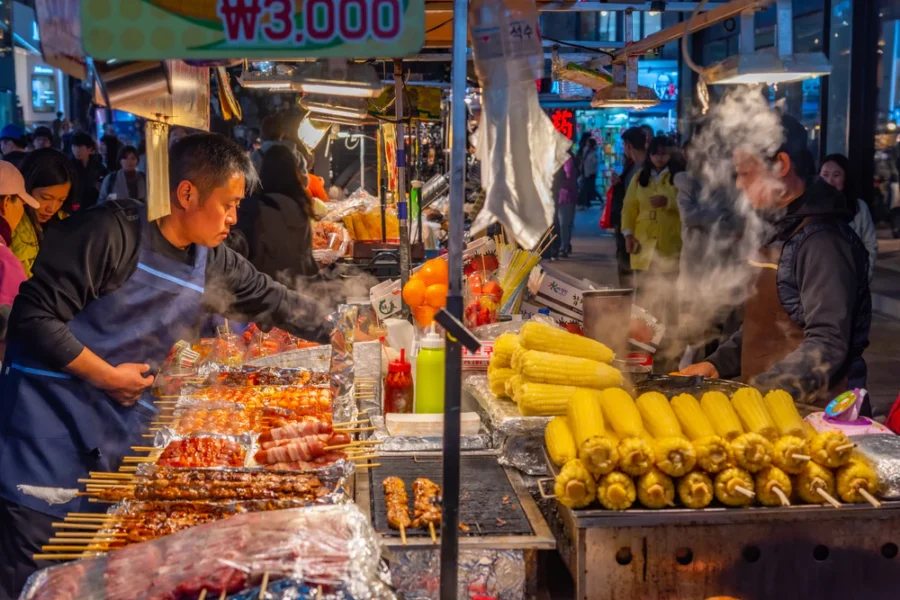
Myeongdong’s food scene is honestly worth the trip alone. The narrow streets fill with vendors cooking up fresh snacks right in front of you, and those smells—sweet, spicy, smoky—hit you before you even see the stalls. Cash is still the easiest way to pay, so keep some small bills handy.
Exploring Street Food Stalls
Most street food stalls cluster along Myeongdong-gil and the little alleys branching off. They usually open by late morning and stay busy well into the night.
Vendors roll out carts loaded with sizzling griddles, bubbling pots, and towers of skewers. Some focus on one thing—like grilled squid or tornado potatoes—while others offer a wild mix.
I like to start at one end of the main street and graze my way down, grabbing a bite at each stop. It’s the only way to try as much as possible without getting stuffed too fast.
Here are a few street food favorites you’ll see everywhere:
| Food Item | What to Expect | Price Range (₩) |
|---|---|---|
| Tornado Potato | Spiral-cut potato on a stick, deep-fried, sometimes dusted with cheese powder | 3,000–5,000 |
| Odeng (Fishcake) | Skewered fishcake simmered in hot broth | 1,000–2,000 |
| Grilled Cheese Rice Cake | Rice cake layered with gooey melted cheese | 3,000–4,000 |
Don’t worry if your Korean isn’t great—vendors are used to people pointing and ordering with a smile.
Tasting Tteokbokki and Hotteok
Tteokbokki is hands down the most Instagrammed street food here. Chewy rice cakes swim in a spicy-sweet gochujang sauce, and some stalls toss in eggs or fishcakes for extra heft.
If you can’t handle much spice, ask for maepji anke (less spicy). I learned that the hard way—one bite and my mouth was on fire for ten minutes.
Hotteok makes the perfect follow-up. These warm, pan-fried pancakes ooze with brown sugar, cinnamon, and nuts. Bite carefully—the filling is molten and messy, but that’s half the fun.
In winter, I grab a hotteok just to keep my hands warm while I wander.
Breakfast at Isaac Toast
If you’re spending the night in Myeongdong, you’ve got to start at least one morning at Isaac Toast. Sure, it’s a chain, but the Myeongdong branch draws travelers for a reason—it opens early and sits just steps from the main shopping drag.
The sandwiches hit that sweet-and-savory spot: toasted bread, a thin omelette, ham or bacon, shredded cabbage, gooey cheese, and this mysterious sweet sauce. It sounds a little strange, but trust me, it works.
I usually grab the ham and cheese with an iced coffee. It’s quick, filling, and honestly, way cheaper than most sit-down breakfasts around here.
If you show up during peak hours, expect a short wait. The line moves fast, though. You can eat on the go, which is perfect if you want to hit the shops before the crowds roll in.
Famous Local Restaurants and Eateries
Myeongdong’s food scene is a mix of old favorites and hidden gems. Some spots have churned out the same beloved dishes for decades; others are tiny corners where locals slip in for a quick bite.
You’ll stumble across places that focus on just one or two things and absolutely nail them. It’s all about simple, satisfying meals that make the detour worth it.
Dining at Myeongdong Kyoja
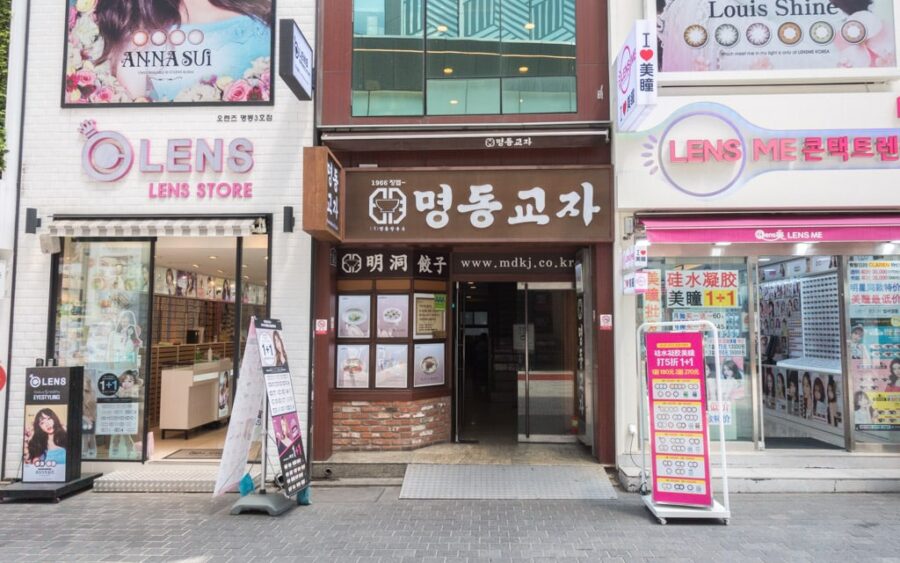
If you ask anyone about Myeongdong eats, they’ll probably mention Myeongdong Kyoja. This noodle shop has been around since the 1960s and still draws a crowd almost every day.
They serve kalguksu—hand-cut wheat noodles in a rich chicken broth—and big, juicy steamed dumplings.
The menu is refreshingly short. You pick noodles, dumplings, maybe a side or two, and that’s it. No need to stand there overthinking.
The broth is clean yet full of flavor, and the noodles have that perfect chew you only get when they’re cut fresh.
Don’t expect to linger. You eat, enjoy, and make way for the next group. But if you want a bite of something that’s been honed over generations, this is the place.
Tip: Go early or pick an odd hour to dodge the lunch rush.
Kalguksu Alley
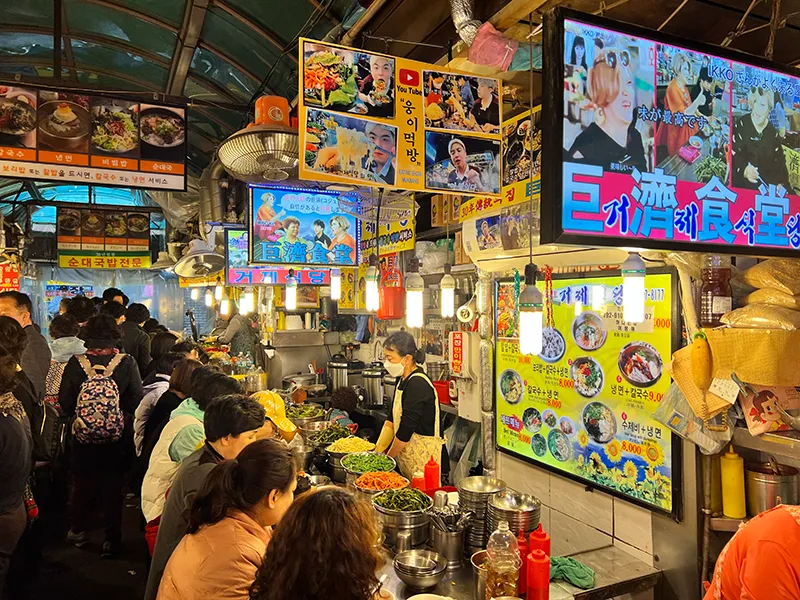
Just a few streets away, you’ll find Kalguksu Alley. It’s a narrow lane, lined with little eateries, each insisting they’ve got the “best” hand-cut noodles.
Honestly, most of them are pretty great, but each puts their own spin on things. Some broths lean garlicky, others go heavy on seafood. A few shops serve mandu (dumplings) with the noodles, while others stick to the basics.
Prices are fair, and you’ll get a hearty portion.
The best part? Pick a shop at random and see what happens. Once, I ducked into a place just because the owner waved me in, and it ended up being my favorite bowl of the trip.
Good to know: Some of these tiny spots still prefer cash.
Nearby Food Markets
If you’re up for a short walk or a quick subway ride, don’t skip Gwangjang Market. It’s not technically in Myeongdong, but close enough to squeeze into your day.
Here, you can try bindaetteok (mung bean pancakes), mayak gimbap (addictive little rice rolls), and freshly made tteokbokki.
The place buzzes with energy—vendors shouting, pans sizzling, sesame oil wafting through the air.
Grab a seat at a stall counter, squeeze in shoulder to shoulder with strangers, and watch your food come together right in front of you.
You’ll get a real taste of Korean street food in one spot. Be ready to eat more than you planned. Honestly, that’s half the fun here.
Day Trips and Nearby Attractions
Seoul crams a lot into its central districts, but some of the best adventures are just a stroll or subway ride away.
Spend the morning in a quiet art alley, grab lunch at a century-old market, and still make it back to Myeongdong before dinner.
Exploring Insadong
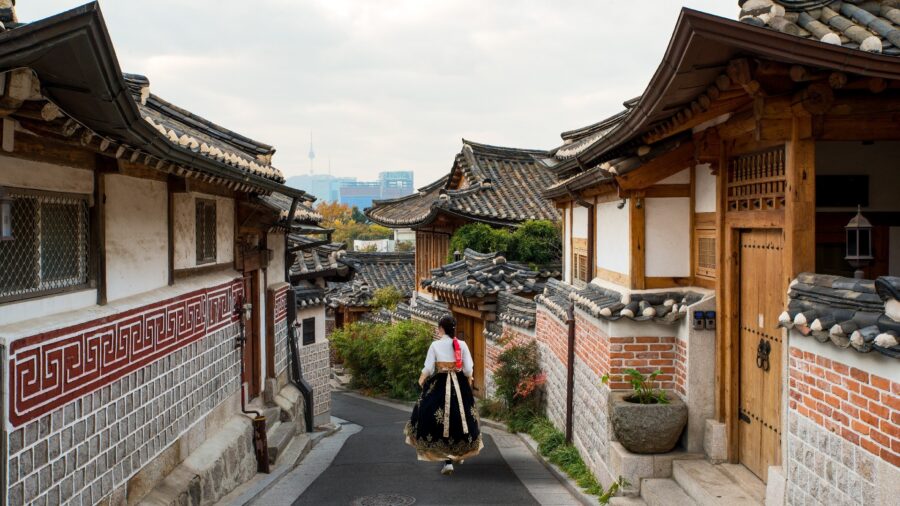
Craving a slower pace after Myeongdong’s chaos? Insadong is the spot. You’ll find traditional tea houses, antique shops, and galleries tucked into winding alleys.
Plenty of hanbok rental shops dot the area if you want to try on Korea’s traditional dress for a photo or two.
I usually start on the main Insadong-gil, then veer off into the smaller alleys. That’s where you’ll find old craft stores and family-run calligraphy shops.
Many sell handmade paper, brushes, and ink you can actually use—not just stuff for display.
Food here sticks to the classics. Try a small bowl of patbingsu (shaved ice with red beans) or stop for a warm cup of omija tea.
If you have a little extra time, book a short guided walk or a cultural class through day tours so you don’t miss the hidden courtyards.
Visiting Gwangjang Market
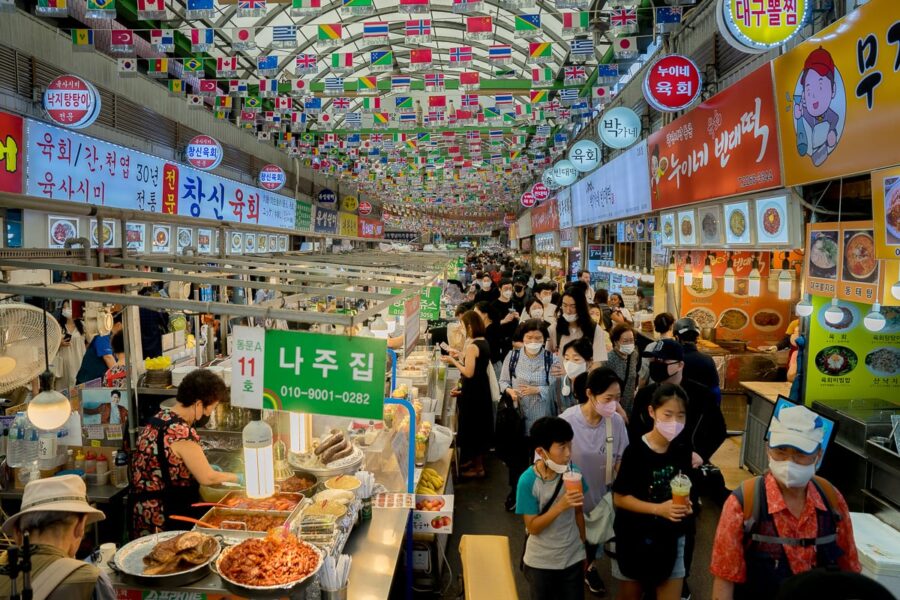
Gwangjang Market is one of Seoul’s oldest, busiest food markets. You can hop on the subway from Myeongdong and be there in no time.
Go hungry. The market is famous for bindaetteok (mung bean pancakes) fried right in front of you, and long counters serving mayak kimbap—tiny rice rolls you’ll probably eat too many of.
It’s not just about food. The second floor has rows of vintage clothing stalls—retro denim jackets, silk blouses, even military surplus gear.
Bargaining is part of the fun, but keep it lighthearted.
Visit in the evening for a lively but not overwhelming vibe. Some of my best meals have been here, squeezed onto a tiny stool, chatting with locals while steam rises all around.
You can also book a guided food tour if you want a local’s help navigating the maze of stalls.
Cultural Stops Beyond Myeongdong

If you’re up for a bit more walking, check out a few cultural spots nearby that most visitors miss. Deoksugung Palace sits about 15 minutes away and blends traditional Korean and Western-style buildings.
The stone wall road next to it is especially pleasant for an afternoon stroll.
Seosomun History Park offers a quieter break. Landscaped paths wind through small exhibits about Korea’s history. It’s not flashy, but it’s meaningful if you like places with a story.
Drop by Myeongdong Cathedral, one of Seoul’s most important Catholic churches. Even if you’re not religious, the Gothic architecture and stained glass are worth a look.
These spots don’t take long to see, so you can easily fit them between shopping or meals.
Frequently Asked Questions
You can easily fill a whole day in Myeongdong—shopping, eating, and stumbling across little cultural surprises between the busy streets.
It’s one of those places where you can wander without a plan and still leave with a packed schedule.
If you time it right, you’ll squeeze in a mix of markets, local eats, and maybe even a quiet moment away from the crowds.
What are the top attractions to include in a Myeongdong day trip?
Start with Myeongdong Shopping Street—it’s the pulse of the district and packed with K-beauty stores and fashion brands.
Pop into Myeongdong Cathedral for a breather and a bit of history. If you’ve got the energy, walk over to Namdaemun Market for a more traditional shopping vibe.
How can I experience the best of Myeongdong’s street food scene?
Head out in the late afternoon when most stalls are open and the energy is buzzing. Try a mix of sweet and savory—hotteok (sweet pancakes), mandu (dumplings), and grilled squid on a stick.
Don’t rush. Grab a bite or two at a time and keep moving so you can sample from different vendors.
What is the recommended amount of time to spend in Myeongdong during a Seoul visit?
If you’re into shopping and food, give yourself at least half a day—longer if you’re the type who gets lost in side streets and pop-up shops.
If you just want a taste, two to three hours works, but you’ll probably miss a few of the smaller gems.
Start with the big names—Innisfree, Nature Republic, Stylenanda—right near Myeongdong Station. Then slip into the smaller alleys for boutique clothing shops and indie accessory stalls.
If you’ve got time, head up to the top floors of department stores like Lotte for local designer brands you won’t spot on the main street.
What are some cultural experiences unique to Myeongdong that I can include in my itinerary?
The cathedral is the obvious pick, but keep an eye out for seasonal pop-up events—sometimes you’ll stumble across K-pop exhibitions or tiny art installations hidden in side streets.
If quirky cafes are your thing, Myeongdong’s got a few animal-themed spots where you can sip coffee next to sheep or meerkats. Not exactly “historic,” but hey, it’s part of the local scene now.
How do I balance my Myeongdong schedule with other Seoul attractions over a 5-day stay?
Honestly, if you want to make the most out of your time, hit up Myeongdong and Namsan Tower on the same day. They’re practically neighbors—grab some street food or get your shopping fix in the morning, then wander up to Namsan Tower for those killer sunset views.
On another day, I’d suggest mixing things up with a stroll through Insadong or diving into the late-night buzz at Dongdaemun. Pairing these neighborhoods gives you a real taste of Seoul’s shopping and culture, all within easy reach.

